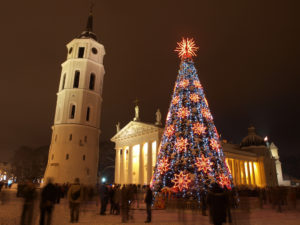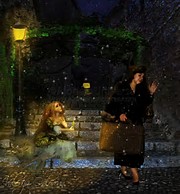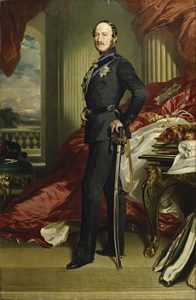
Preparing for Christmas in Lithuania means cleaning: the house is cleaned, bed sheets are changed and family members take a bath and wear new clothes. At one time even trees were wrapped in fresh straw. Though the days of a rigorous fast are over and people now longer have to be content on Christmas Eve with a handful of peas, many Lithuanians refrain from meat and will not sit down to dinner until the first star is visible in the evening sky.
A number of eastern Christmas customs can be observed at the Kucios or Christmas Eve dinner: the straw on the table (a sign of fertility and a symbol of Christ’s birth in a stable), the round wafers, a place set for the dead or absent family members and twelve meatless dishes. On the traditional menu would be fish, potato pancakes, sauerkraut, beet soup, mushrooms in sour cream with fruit compote, grain pudding, poppy-seed milk and cookies for dessert. It was customary in some Lithuanian familes to leave some food on the table after dinner in case the Holy Family passed by. Another lovely tradition is for each member of the family to place a straw for every gracious word or act which occurred at Christmas into a cradle which is laid under the Christmas tree for the baby Jesus.
A recent addition to Lithuanian Christmas is the Christmas tree which first became popular in the 1920s and 1930s. The custom was to decorate the tree away from the sight of the children, usually with home-made orrnaments fashioned from straw, fruit and candies and lit by real candles. After dinner the tree and the gifts are revealed to the children who then open the presents brought by Kaledu Senelis, Grandfather Christmas. Often the gift-bringer appears in person on Christmas Eve and before handing over the presents he will demand that the recipient earn the gift by reciting a poem, playing an instrument or singing a song. After the excited kds are put to bed adults go to the midnight church service called the Shepherds’ Mass.
Epiphany marks the end of the Christmas season in Lithuania. The tree is stripped of its remaining candies and treats by the children and the decoratiions are put away for another year.
Lithuanian customs include many different means of divination especially for determining one’s future spouse. Unmarried people draw a piece of straw from under the Christmas Eve tablecloth: a long, thin stalk betokens a tall, thin husband; a short, thick stalk indicates a short, fat husband. If a married person draws a thin piece it means a bad year economically, a fat piece means a fat wallet. If a married woman pulls a straw that is thicker in the middle, she will have a baby that year. In a kind of Christmas Rorschach test, interpreting first impressions from a crumpled piece of paper or a blob of wax in cold water can also yield glimpses of the future: a form of transportation means travel in the new year; a house or building means a move; a flower points to a wedding; a cradle, a birth; and a coffin or burning candle, death. Those with flexible young bodies were urged to attempt this form of divination: after supper on Christmas Eve, go into a room, place a mirror against a door and, bending down, look at the mirror through their legs; in it will be revealed the future husband or wife.





